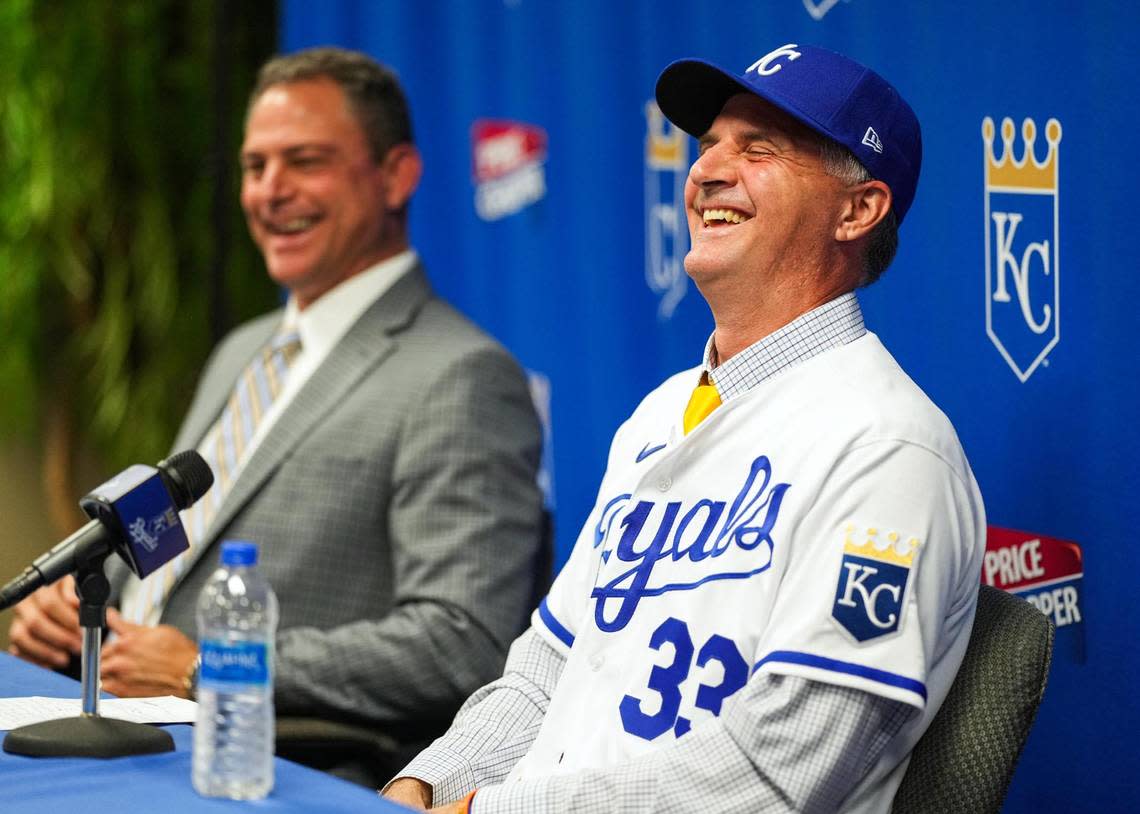Opening day is Royals’ chance for new-look team to show changes aren’t just cosmetic

To be sure, opening day is always about renewal and regeneration and the attached possibilities and hopes of how the season might play out. If that stuff sounds trite, well, it’s also because it’s true.
Even framed in that context, though, this one arrives amid a remarkable set of circumstances converging in nearly a generational sense of change and freshness in the Royals organization.
At least, that is, beyond just about everything but the venerable and infinitely appealing battery of 39-year-old Zack Greinke and Sal Perez (32) battery for the opener against Minnesota on Thursday afternoon at Kauffman Stadium.
Glancing around the freshly renovated interview room in Kauffman, first-year manager Matt Quatraro smiled and noted the “little feng shui” changes.
His playful reference to the ancient Chinese belief that “the way your house is built or the way that you arrange objects affects your success, health and happiness,” per the Cambridge Dictionary, could just as aptly have been referring to numerous other changes intended to harmonize the franchise.
That’s evident from the shuffle atop the front office for the first time since 2006 to the contrasting shift to a manager noted for his laid-back demeanor and engagement with analytics to a roster bubbling with young players — including several who will appear in baseball’s grand opening celebration for the first time.
This journey will unfold over the canvas of Major League Baseball rule changes — most notably the institution of a pitch clock — intended to expedite and energize the game. (With his trademark grin, Perez said he thinks the shorter games will extend his career by a couple years.)
All while the Royals continue to pursue a momentous move to an estimated $2 billion downtown ballpark district that chairman and CEO John Sherman nonetheless says is secondary in his thoughts to how this team is going to play.
Along with the gleaming new KCI, the streetcar expansion, the Kansas City Current’s stadium project and the still-amazing reality that the Chiefs have won two of the last four Super Bowls and figure to be a perennial contender for years, this time in Royals history could be part of the broader sensation of everything being up to date in Kansas City.
Could, of course, is the operative term as the Royals endeavor to reverse the dismal recent past in which they averaged 98 losses over their last four full seasons (not including the pandemic-shortened 2020 season).
Because it’s all just theoretical and tentative until they can demonstrate that this all equates to real change on the field and goes beyond the cosmetic.
“The first priority is really the on-field product,” Sherman said Wednesday, “because that really lifts everything else.”
The heavy lifting will require taming numerous variables, particularly resetting the starting pitching, orchestrating a made-over bullpen and optimizing what they believe is enormous potential in their young nucleus of hitters.
But after the Royals went 65-97 a year ago and fired president of baseball operations Dayton Moore and manager Mike Matheny, it’s reasonable to ask what we might expect and how to gauge the impact of the operational overhaul.
At one end of the spectrum …
The goal of every team every season is to win the World Series, Perez reminded, adding, “That’s why we’re here.”
Vinnie Pasquantino emphatically said “make the playoffs,” adding that if you’re not entering the year “trying to extend your season, to be honest, I don’t really know what you’re doing.”
Without putting a ceiling on anything, though, Sherman and executive vice president and general manager J.J. Picollo pointed to indicators more than pure and simple results.
“I’m kind of looking,” Sherman said, “for a step forward.”
Winning games would make for fine evidence.
But while the energy at spring training in Surprise was “palpable,” Sherman said, for now he will measure this in the more intangible “are we going in the right direction?” toward being able to compete for a championship again.
It could be in little things or big, in the nuanced or obvious.
No doubt, though, that he expects to see it … and that we’ll know it when we see it, too.
“Last year,” he added, “I didn’t feel like we took that step.”
For all the changes the Royals have made, prognosticators aren’t optimistic about their prospects of major progress.
But first things first in a marathon season.
They could be compelling, or at least provide reassurance, if they don’t stumble out of the gate again.
Last season, they were 16-32 at the end of May.
Much like ruinous starts to their last three full seasons: 33-46 at the end of June in 2021, 9-20 at the end of April in 2019 and 7-21 at the end of April in 2018.
Simply put, they can’t afford another false spring if they’re going to make strides and recapture the imagination of fans.
Honestly, it’s hard to know how to perceive where they are and where they’re going this season.
But we’re going to take our cue from the guy players are calling “Q”:
After he was hired, Quatraro said he didn’t invest a lot of time heavily researching individual players.
“I didn’t want someone else,” he said, “to tell me what to think of them.”
Starting Thursday, the Royals have a chance to tell us directly.
With so much that’s so new, the fresh feng shui will reverberate if the results follow — incremental or otherwise.

 Yahoo Movies
Yahoo Movies 
